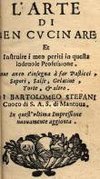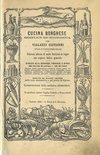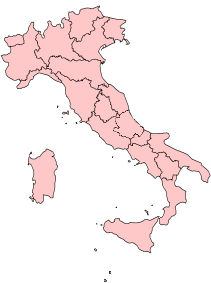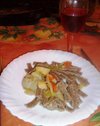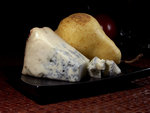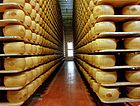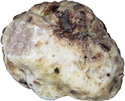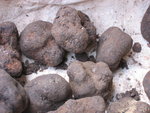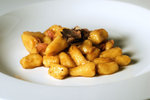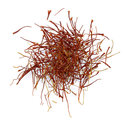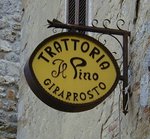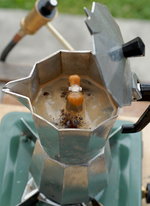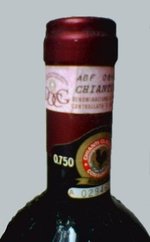Cuisine of Italy
| Foods |
|---|
|
Bread - Pasta - Cheese - Rice |
| Preparation techniques and cooking items |
| Techniques - Utensils Weights and measures |
| See also: |
| Kitchens - Meals Wikibooks: Cookbook |
Italian cuisine as a national cuisine known today has evolved from centuries of social and political change. Its roots can be traced back to 4th century BCE and into the Middle Ages which brought Arab and Norman influence to certain regions along with introduction of notable chefs such as Maestro Martino who cooked an elegant refined Italian cuisine. The cuisine significantly changed with discovery of the New World helped shape much of what is known as Italian cuisine today with introduction of items as potatoes, tomatoes, bell pepper and maize, which are all central parts of the cuisine but were not introduced in scale until the 18th century.
Ingredients and dishes vary by region. There are many significant regional dishes that have become both national and regional. Many dishes that were once regional, however, have proliferated in different variations across the country in the present day. Cheese and wine are also a major part of the cuisine, playing different roles both regionally and nationally with their many variations and Denominazione di origine controllata (DOC) (regulated appellation) laws. Coffee, and more specifically espresso has become highly important to the cultural cuisine of Italy.
History
Italian cuisine has evolved extensively over the centuries. Although the country known as Italy today had not officially formed until the 19th century, the cuisine can claim roots going back as far as 4th century BC. Through various influences throughout the centuries, including neighboring regions, conquerors, high-profile chefs, political upheavals as well as the discovery of the New World, a concrete cuisine has formed to what is known today as one of the premiere cuisines in the world.
Antiquity
- See also: Roman cuisine
The first known food writer has been traced back to the 4th century BCE. This writer was a Greek Sicilian named Archestratus, who lived in Syracuse. His writing was a poem that spoke of using "top quality and seasonal" ingredients of the freshest nature. He also stated that the flavors of the dishes should not be masked by spices, herbs, or other seasonings with an importance put upon this style of preparation for fish. This style of cuisine seemed to be forgotten during the 1st century AD when De re coquinaria was published with 470 recipes included many with heavy usage of spices, herbs which would hide much of the natural flavor of the dish they were used in, much of this would have been considered what would be eaten in the patrician household. This does not suggest that the Romans of the time did not appreciate high quality ingredients. The Romans employed the best Greek bakers to produce their breads, imported pecorini from Sicily as the Sicilians were known for producing the best cheese makers. The Romans were also known as being excellent rearer of pigs for butchering and gardening of artichokes and leeks.
Middle Ages
- See also: medieval cuisine
Muslims invaded Sicily during the 9th century as most of what is known today as Northern Europe was being attacked by Viking raiders. As Sicily has already attained much of the culinary traditions from Rome and Athens, the highly civilized culture combined with the Sicilian to bring what many consider the first real Italian cuisine in Sicily. The Arabs introduced spinach, almonds and rice and some say spaghetti as it made its possible first appearance during the 12th century AD when the Norman king made a survey of Sicily and noted that he saw people making long strings made from flour and water called atriya, which eventually became trii which is another term used for spaghetti in southern Italy. Normans also introduced casseroling, salt cod (baccalà) and stockfish which remain extremely popular today.
Food preservation techniques were a necessity as refrigeration had not yet been invented. The two types of preservation were either chemical or physical. Meats and fish would be smoked, dried or kept on ice. Brine and salt were used to preserve items like pickles, herring and to cure pork meat. Root vegetables were also preserved in brine after they had been parboiled. Other items used to preserve foods included oil, vinegar or immersing animal proteins in their own congealed, rendered fat. For preserving fruits, liquor, honey and sugar were used.
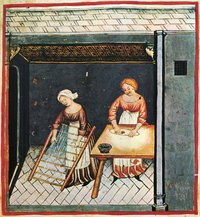
The northern regions of future Italy started to show a mix of Germanic and Roman culture while the southern portion continued to reflect the influences of Arab culture as they controlled much of the Mediterranean trade routes, as such much of the Mediterranean cuisine had been spread by the Arab trade. The oldest Italian book on cuisine is Liber de coquina written in Naples during the 13th century. Dishes included "Roman-style" cabbage (ad usum romanorum), ad usum campanie which was "small leaves" prepared in the "Campanian manner", a bean dish reflecting the Marca di Trevisio, a torta, compositum londardicum which are extremely similar to dishes prepared today in Italy. In two other books from the 14th century recipes are found for Roman pastello, Lavagna pie, use of salt from Sardinia or Chioggia again reflecting the importance of the regions of Italy and the foundations of integral dishes.
During the 15th century Maestro Martino was chef to the Patriarch of Aquileia at the Vatican. His manuscript Libro de arte coquinaria began to illustrate a cuisine with a more refined and elegant design. In his book contains a recipe for Maccaroni Siciliani which was made by wrapping dough around a thin iron rod and dried in the sun. The macaroni was to be cooked in capon stock flavored with saffron, illustrating the Arab influence. Of particularly note is Chef Martino's shedding the use of excessive spices in favor of fresh herbs. Martino's cuisine created a methodology that respected proper selection and modes of preparation. The Roman recipes mentioned in the text includes recipes for coppiette and cabbage dishes. His Florentine dishes included eggs with a Bolognese torta, Sienese torta and for Genoese recipes such as piperata, macaroni, squash, mushrooms, and spinach pie with onions.
Martino's manuscript was included in a book printed during 1475 in Venice written by Bartolomeo Platina entitled De honesta voluptate et valetudine ("On Honest Pleasure and Good Health"). Platina puts Martino's "Libro" in cultural context reflexing different regions of Italy including the Po Valley, Liguria, Campania, Piceno, Apulia, and Sicily. He speaks of ingredients coming from various regions perch from Lake Maggiore, sardines from Lake Garda, grayling from Adda, hens from Padua, olives from Bologna and Piceno, turbot from Ravenna, rudd from Lake Trasimeno, carrots from Viterbo, bass from Tiber, roviglioni and shad from Lake Albano, snails from Rieti, figs from Tuscolo, grapes from Narni, oil from Cassino, oranges from Naples and moray from Campania. Grains from Lombardy and Campania are also mentioned as is honey from Sicily and Taranto. The wines he mentions are from the Ligurian coast, Grecco from Tuscany and San Severino and Trebbiano from Tuscany and Piceno.
Early modern era
The courts of Florence, Rome, Venice and Ferrara were integral to the creation of the fine cooking in Italy. The court of Estes in Ferrara was a central figure to the creation of this high-cuisine. Christoforo Messisbugo steward to Ippolito d'Este published Banchetti Composizioni di Vivande in 1549. In this work Messisbugo details banquets in the first-half of the book, in the second-half of the book contains a multitude of recipes for items such as pies and tarts (containing 124 recipes with various fillings). The work does emphasize the use of Eastern spices and sugar which was at this time otherwise beginning to diminish.
In 1570 Opera was written by Bartolomeo Scappi personal chef to Pope Pius V. This was a five-volume work that to that date encompassed the most comprehensive example of Italian cooking. The work contained over 1,000 recipes, with information on banquets including displays and menus as well as illustrations of kitchen and table utensils. The difference between most books written for the royal courts and this volume is its shedding of game and other meats and includes instead domestic animals and courtyard birds which was more inline with the "modest household". Recipes are also included how to clean and use lesser cuts of meats including tongue, head, and shoulder. The third book contains recipes for fish, or Lent cookery. Preparations for fish are simple including poaching, broiling, grilled, or fried after being marinated. Particular attention is given to seasons in which fish should be caught and in which location. The final volume includes pies, tarts, fritters and includes a recipe for a Neapolitan pizza. This version of the Neapolitan pizza is not the savory version known today, it was instead a sweet version as tomatoes had not been introduced to Italy as-of-yet. There were recipes for corn and turkey however, which were items from the New World.
During the first decade of the 17th century chef Giangiacomo Castelvetro published Brieve Racconto di Tutte le Radici di Tutte l'Herbe et di Tutti i Frutti (A Brief Account of all Vegetables, Herbs and Fruit) which was translated into English by Gillian Riley. Originally from Modena, Castelvetro moved to England because of his Protestant background. The book included an in-depth listing of Italian vegetables and fruits as well as their preparation. The chef's preparation of vegetables featured them at times as a central part of the meal, not just accompaniments. The favored preparation (still popular in Italy today) was to simmer vegetables in salted water and serving them warm or cold with olive oil, salt, fresh ground pepper, lemon juice and verjus or orange juice. Another preparation includes roasting vegetables wrapped in damp paper over charcoal or embers with a drizzle of olive oil, again a technique still popular today in Italy. Castelvetro's book is separated into seasons with mentions of hop shoots in the spring and truffles in the winter detailing the truffle scavenge with the use of pigs. New World items were not mentioned in this book as they did not become popular until the 18th century.
In 1662 Bartolomeo Stefani chef to Gonzagas published L'Arte di Ben Cucinare. He was the last chef to publish a book of Italian high-cuisine, but the first to offer a full section on vitto ordinario ("ordinary food"). The book contained a section on a banquet given by Gonzagas for Queen Christina of Sweden with details for preparation prior to the banquet, preparation of the food and table settings including each guest having a setting of a knife, fork, spoon, glass, a plate instead of bowls often used up to this point and a napkin. Other books were published at this time to illustrate how scalco (server) should manage themselves while serving their guests. An important book to take up this topic was Galatheo by Giovanni della Casa. The book instructed waiters to not scratch their heads or other parts of themselves, not to spit, cough or sneeze while serving diners. The book also instructed diners to not use their fingers while eating as well as not wipe their sweat with their napkin.
Modern era
Much of what is known as Italy today was still governed by France, Spain and Austria in the 18th century. In turn it was at the beginning of the 18th century that the culinary books of Italy began to show the regionalism of Italian cuisine in order for Italian chefs to better show the pride of their regions instead of the high cuisine of France. The books written at the time were also no longer addressed to professional chefs but to bourgeois housewives who could address their home cook. Originating in booklet form, periodicals such as La cuoca cremonese (The cook of Cremona) written in 1794 gives a sequence of ingredients according to season along with chapters on meat, fish and vegetables. As the century progressed these books increased in size, popularity and frequency, while the price to attain them dropped well within the reach of the general populace.
The 18th century peasant diet consisted of heavy foods. Taken more as an animosity toward the high cuisine of the affluent which was more refined and delicate, this diet gave the peasantry their own identity. Even medical texts of the time written by the elite warned peasants from eating refined foods as it was poor for their digestion and their bodies required a more substantial heavy meal to suppress their hunger. It was also thought that peasants had coarse stomachs which were unable to digest refined foods. It was also thought by some that peasants ate poorly because they wanted to eat poorly resulting from the fact that many peasants had to resort to eating rotten foods and moldy breads to survive.
In 1779 Antonio Nebbi from Marche wrote Il Cucoco Maceratese. In this book Nebbi addressed the importance of local vegetables plus pasta and gnocchi. Instead of pureed soups in the French style, they included Mediterranean vegetables along with pasta or rice. For stocks, vegetables and chicken were favored over meat. Similarly Vincenzo Corrado wrote Il Cucoco Galante in Naples in 1773 which featured regional vegetables and ingredients. Particular emphasis was given to Vitto Pitagorico (vegetarian food) in his words "Pitagoric food consists of fresh herbs, roots, flowers, fruits, seeds and all that is produced in the earth for our nourishment. It is so called because Pythagoras, as is well known, only used such produce. There is no doubt that this kind of food appears to be more natural to man, and the use of meat is noxious." It was also this book that the tomato took its first central role with thirteen recipes. Zuppa alli Pomidoro first appears in Corrado's book which was the early rendition of Tuscan Pappa al Pomodoro. In Corrado's 1798 edition he introduced a "Treatise on the Potato" after the approval of France through Antoine-Augustin Parmentier's successful promotion.
In the 19th century changes could even be noticed in the writing of chef Giovanni Vialardi, chef to the first king of Italy. In his book A Treatise of Modern Cookery and Patisserie published in Turin Vialardi wrote on recipes "suitable for a modest household." Many of his recipes included regional dishes from Turin including twelve recipes for potatoes Genoese Cappon Magro, still an integral regional dish today. Published in 1829, Il Nuovo Cuoco Milanese Economico written by Giovanni Felice Luraschi feature dishes regional to Milan including Kidney with Anchovies and Lemon and Gnocchi alla Romana, also essential to this day. Gian Battista and Giovanni Ratto published La Cucina Genovese in 1871 addressed the regional cuisine of Liguria. This book contained the first recipe for pesto. La Cucina Teorico-Pratica written by Ippolito Cavalcanti mentions the first recipe for pasta with tomatoes in his conversational tone not often seen before this time.
Regional cuisines
Each area has its own proud specialties, primarily at regional level, but also even at provincial level. These regional variances can come from the influence of a bordering country (such as France or Germany), vicinity to the ocean or mountains as well as economic progress. Italian cuisine is not only highly regional, but is also distinguished by being very seasonal with high priority placed on the use of fresh, seasonal produce.
Friuli-Venezia Giulia
Friuli-Venezia Giulia shares many traditions with the bordering former Yugoslavia. The famous San Daniele del Friuli hams come from this region. Carnia in the northern region is known for its bacon and Montasio cheese. Collico, Grave de Friuli, and Colli Orientali are regional wine favorites. The dishes of the region take on the influence of Austrian, Hungarian, Slovenian, and Croatian dishes. Beer halls of the region feature Viennese sausage, goulash and Bohemian hare. Many of the desserts of the region are flour based, such as strudels. Polenta is a staple of Venezia Giulia where it finds its way into many variations including stirred dishes, baked dishes and can be seen served with sausage, cheese, fish, or meat. Dishes made with pork are often seen in Venezia Giulia and can often be spicy and are often prepared over the open hearth called the fogolar.
Veneto
Veneto is well known for risotto is a dish where the added ingredients differ by according to location, with fish and seafood being added closer to the coast and pumpkin, asparagus, radicchio and frogs' legs appearing further away from the Adriatic. Beans and other legumes are seen in these areas with the dish pasta e fagioli being a unique combination of beans and pasta. Veneto features heavier dishes using exotic spices and sauces. Ingredients like stockfish or simple marinated anchovies are found here as well. Less fish is eaten in Veneto and more meat and sausages are preferred such as the famous sopressata and garlic salami. High quality vegetables are prized here with red radicchio from Treviso being prized as well as asparagus from Bassano del Grappa.
Trentino-Alto Adige/Südtirol
Prior to the Council of Trent in 1550 Trentino-Alto Adige/Südtirol was known for simplicity in cuisine. When the prelates of the Church came they brought the art of fine cooking to the region. Fresh water fish is a specialty of this region. In later years the cuisine of the Republic of Venice and the Habsburg Empire were adopted. In the Alto Adige Alpine traditions are embraced which includes Slav, Austrian, and Hungarian cuisines. Goulash can again be found here as a regular Sunday dish. Potatoes, dumplings and homemade sauerkraut called crauti. Lard is a popular ingredient in this region. The national pasta, tomatoes and olive oil can be found popularized in this region as well.
Lombardy
Rice is a popular ingredient in Lombardy often found in soups as well as risotto. Cheese is a popular course with robiola and grana padano being particularly important (the vast plains of central and southern Lombardy allowing for intensive cattle-raising). For the same reason Butter is a popular ingredient over oil and cream in generous amounts are often seen. Single pot dishes are popular here with the working class which take less labor to create. In the areas of Bergamo, Brescia, and Valtellina polenta is popular. In Mantua village festivals feature tortelli di zucca (ravioli with pumpkin filling) accompanied by melted butter and followed by turkey stuffed with chicken or other stewed meats.
Val D'Aosta
Bread thickened soups of the hearty variety are customary in this region as well as cheese fondues called fonduta typical of the Alpine region. Polenta is another popular staple along with rye bread, smoked bacon, and game meats found in the mountain and forest regions. Butter and cream are also important ingredients in the creation of stewed, roasted and braised dishes.
Piedmont
Piedmont is a region where seasonal gathering of nuts, fungi, cardoons as well as seasonal hunting (especially wild game) and fishing takes place. Truffles, garlic, seasonal vegetables, cheese and rice are all important staples to the region's diet. Wines such as Barolo, Barbaresco, Nebbiolo, and Barbera stand out in this area as well as fine sparkling wines. Gorgonzola and Castelmagno are prized cheeses of the region. Prosciutto Baciato is the regions style of prosciutto made from pork fillet or other lean portion of pork marinated in white wine, coated with a salami paste and stuffed into a casing to age for six months.
Liguria
Liguria highly supports the use of local ingredients, the dishes found in this region will all feature the utmost freshness found in the local produce. Fresh herbs and vegetables as well as seafood find their way into the cuisine. Savory pies and cakes are popular in the region. Onions and olive oil are found often in the cuisine which were helpful in their addition to vitamin C for the sailors who may have been lacking in the vitamin on long journeys. The Ligurians, constricted by a lack of terrain suited to wheat productions, made the most of chick-pea in farinata (plain or topped with onion, artichokes, sausage, cheese or young anchovies) and polenta-like panissa. Hilly or mountainous districts used chestnuts as a ready source of carbohydrates and sugar. Ligurian pastas include corzetti from the Polcevera valley, pansoti, a triangular shaped ravioli filled with vegetables, piccagge, pasta ribbons made with a small amount of egg and commonly served with artichoke sauce or pesto, trenette, made from wholewheat flour cut into long strips and served with pesto, boiled beans and potatoes, and trofie, a Ligurian gnocchi made from wholegrain flour or white wheat flour, made into a spiral shape and cooked with beans and potatoes and often tossed in pesto.
Emilia-Romagna
Emilia-Romagna is well known for its cured hams and mortadella are popular charcuterie items of the region. Parmesan cheese proliferates in the cuisine and different meats including game meats can be found here. Pasta is quite popular in the region. The region of Parma offers exquisite ham and culatello. Bologna offers its top quality mortadella as well as lasagna and tortellini but the home of tortellini is Piacenza. Aceto balsamico tradizionale or balsamic vinegar is produced by legal traditions by old-style producers.
Tuscany
Simplicity is popular in the cuisine in Tuscany. Legumes, bread, cheese, crisp vegetables, mushrooms and fresh seasonal fruit are popular food items. Olive oil is an integral ingredient in Tuscany made from the Moraiolo, Leccino, Frantoio, and Pendolino olives. White truffles from San Miniato are a distinct specialty that appear in October and November. Beef of the highest quality come from the Chiana Valley, specifically a breed known as Maremma used for the famed t-bone steaks known as Florentine steak. Pork is another integral protein to the Tuscan cuisine.
Umbria
Most of the dishes of Umbria are prepared with the simple techniques of boiling and roasting with the addition of local olive oil and herbs for flavor. Vegetable dishes are more popular in the spring and summer while they are in season, while the fall and winter introduces meats from the hunting season and black truffles from Norcia. Sausage making is very popular in this region produced by the Norcini (Umbrian Butchers, native of Norcia). Lenticchie di Castelluccio are prized lentils found in Castelluccio and are highly prized throughout Italy. The regions of Spoleto and Monteleone are known for their production of high-quality spelt. Freshwater fish are also found in the cuisine including lasca, trout, freshwater perch, grayling, eel, barbel, whitefish, and tench.
Marche
On the coast of Marche, fresh fish and seafood proliferate. In the inland regions wild and domestic pigs are prized in the cuisine often making their way into sausages, hams and other skilled delicacies. Here instead the hams are not thinly sliced, but cut into bite-sized chunks when served. Suckling pig, chicken and fish are often stuffed in this region before being roasted or placed on the spit.
Lazio
Hearty pasta dishes find their way into the cuisine of Lazio, like the renowned amatriciana pasta dressing, based on spicy red pepper and guanciale, a kind of bacon-like cold cut (with more meat and less fat). The region prides itself on being able to use the lesser known cuts of pork and beef in tasty dishes, with examples in preparations like the entrail-based pajata and coda alla vaccinara. While these are memento to the ingenuity of plebeians and peasants having to make-do with little resources several other dishes are derived from the tables of Roman patricians, Popes and cardinals, thus relying on much more prized and valuable ingredients. Some Jewish influence can also be seen in the cuisine, with Jews having been part of Roman milieu since the times of Vespasianus. Local vegetables, especially globe artichokes, are popular in the Roman cuisine.
Abruzzo and Molise
Chilies (peperoncini) are seen in the cuisine of Abruzzo where they are called diavolini ("little devils") for the spicy heat they add to dishes. Centerbe ("Hundred Herbs") is a strong, spicy herbal liqueur drunk by the local people here. Pasta, meat, and vegetables are central to the cuisine of Abruzzo and Molise. Lamb can be seen here often and is frequently and successfully combined with pasta. A special tool used to cut the local pasta is the chitarra (literally "guitar"), a fine stringed tool that the dough is pressed through. Saffron is a favorite spice of the region, grown in the town of L'Aquila. Although its popularity has slightly waned in recent years it can still be seen in some dishes which are central to Italian cuisine.
Campania

High-quality produce of Campania includes tomatoes, peppers, spring onions, potatoes, artichokes, fennel, lemons and oranges which all take on the unique flavor of the volcanic soil of the region. The Gulf of Naples offers top-quality fresh fish and seafood. Durum wheat is used in the production of the region's pastas. The mozzarella is highly prized here as it is of the highest quality coming from buffalo milk. The traditional pizzas of the region are extremely well known and take advantage of the fresh vegetables and cheese found there. Desserts are not to be overlooked, with pastiera, sfogliatelle and rum-dipped babà being the most famous ones.
Apulia
The northern portion of Apulia uses copious amounts of garlic and onion. The region is known for its dried pasta made from durum wheat flour. Fresh vegetables come in the way of tomatoes, zucchini, broccoli, bell peppers, potatoes, spinach, eggplants, cauliflower, fennel, Belgian endive, as well as legumes such as chickpeas, lentils and beans. Apulia is the largest producer of olive oil in Italy. The closeness to the sea brings a proliferation of fish and seafood to the table, especially oysters, and mussels. Goat and lamb are seen on the table here occasionally as well.
Basilicata
Pork is an integral part of Basilicata's cuisine, often made into sausages or roasted on a spit by home cooks. Mutton and lamb are also popular meats in the region. Pasta is another common ingredient to the cuisine here, made from duram wheat and water. The accompanying sauces for the pasta are generally of the meat or vegetable based variety. Spicy peperoncini are also popular in Basilicata. The bitter digestif Amaro Lucano is from this region, but is actually popular all over Italy.
Calabria
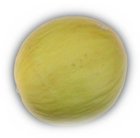
The cuisine of Calabria has been highly affected by the constant conquerors and visitors of the region's past. The Arabs introduced oranges, lemons, raisins, artichokes and egg plants. Cistercian monks introduced agricultural practices to the region along with their skills in processing dairy products. French rule under the House of Anjou, and later Napoleon, along with Spanish influence, affected the language and culinary skills as seen in the naming conventions of items such as cake, gatò, from the French gateau. In time the region has taken on its own characteristics and distinct regional cuisine based on these influences. Seafood proliferates in the cuisine due to its orientation to the coast line with swordfish being of note along with shrimp, lobster, sea urchin, squid and others. Melons also grow well in this region with watermelon, charleston gray, crimson sweet, cantelope, tendrale verde, piel de sapo and invernale giallo being popularly served in a chilled Macedonia di frutta (fruit salad) or wrapped in Prosciutto.
Sicily
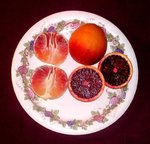
Template:Main Sicily is another region filled with culinary influences because of its location. The influence of the Ancient Greeks can be found here: Dionysus has been said to have introduced wine to the region. The Romans later conquered the island and introduced lavish dishes based on goose. The Byzantines introduced sweet and sour flavors while during the 10th and 11th centuries the Arabs brought apricots, sugar, citrus, sweet melons, rice, saffron, raisins, nutmeg, clove, black pepper, and cinnamon which are all still seen in the cuisine today. The Normans and Hohenstaufens introduced a fondness for meat dishes. The Spanish introduced numerous items from the New World including cocoa, maize, turkey, tomatoes and other produce items. Tuna, sea bream, sea bass, cuttlefish, swordfish and other seafood available off the coastline is an integral part of the modern cuisine.
Sardinia
Sardinia was a region once fought over fiercely by many powers, the coastal cuisine of fish and seafood has only flourished after much history had passed as the inhabitants of the region wisely kept away from the coastline so highly cherished by invading traders of the area. Today rock lobster, scampi, squid, tuna, sardines and other seafood and fish figure prominently into the cuisine. Suckling pig and wild boar figure prominently, often roasted on the spit or boiled in hearty stews of beans, vegetables and thickened with dry bread rounding out the meal. Fresh herbs such as mint and myrtle are popular in dishes as well. Sardinian bread is made in a drier format, which keeps longer than high-moisture breads as well, examples include civraxiu, coccoi pinatus, a highly decorative bread and pistoccu made with flour and water only, meant to travel distances with herders but served at home often with tomatoes, basil, oregano, garlic and a strong cheese.
Meal structure
Also See Food
Meals are structured in a cyclical order in Italy and variable contain no less than 3-4 courses. Meals are seen as a time to spend with family and friends instead of immediate sustenance, as such the regular daily meals can be a bit longer than other cultures. During holidays, many family feasts will last for many hours, if not the entire day.
In many homes today the traditional Italian menu is kept for high days and special events (as weddings) while the everyday menu only includes the first and second course, the side dish and coffee. One notable aspect of an Italian meal, is that the primo or first course, is usually the more filling dish and will consist of either risotto or pasta, both being rich in carbohydrates. Modern Italian cuisine also includes single courses (all-in-one courses), providing carbohydrates and proteins at the same time (e.g. pasta and legumes).
- Antipasti
- literally "before (the) food", hot or cold appetizers
- Primo
- "first course", usually consists of a hot dish like pasta, risotto, gnocchi, polenta or soup.
- Secondo
- "second course", the main dish, usually fish or meat. Traditionally veal, pork and chicken are the most commonly used meat, at least in the North, though beef has become more popular since World War II and wild game is very popular, particularly in Tuscany. Fish are those which are caught locally.
- Contorno
- "side dish", may consist of a salad or cooked vegetables. A traditional menu features salad along with the main course.
- Formaggio and frutta
- "cheese and fruits", the first dessert, usually served together
- Dolce
- "dessert", such as cakes and cookies
- Caffè
- coffee/espresso
- Digestivo
- "digestives", liquors/liqueurs (grappa, amaro, limoncello) sometimes referred to as ammazzacaffè ("coffee killer")
Dining out
Italy offers many options for dining out or getting a drink. Each type of establishment has a defined role and traditionally sticks to it. Below is a listing of various dining and drinking establishments one might find in Italy.
Places to dine out
- Agriturismo - Working farms that often offer accommodations and meals. Often the meals are served to guests only. Marked by green and gold sign with a knife and fork on it.
- Bar/Caffé - Popular locations which serve coffee, soft drinks, juice and alcohol. Traditional hours are from 6am to 10pm. Common foods sold include brioche, panini, tramezzini or spuntini (snacks) which can include olives, potato crisps and small pieces of frittata.
- Birreria - A bar that offers beer found in central and northern regions of Italy.
- Frasca/Locanda - Friulian wine producers that often open for the evening and many stay open late offering food along with their wines.
- Osteria - Focused on simple food of the local region, usually only having a verbal menu. Many are open at night only but some open for lunch from 12:30 to 3pm. They will then reopen at 7pm for dinner with a late closing time.
- Paninoteca - Sandwich specialty shop open during the day.
- Pizzeria - Wood fired pizzas are a specialty of Italy.
- Polentaria - A regional establishment seen in limited number in the northern part of Italy above Emilia-Romagna.
- Ristorante - Often offers upscale cuisine with more refinement along with printed menus.
- Spaghetteria - Originating in Napoli, offering pasta dishes and other main courses.
- Tavola Calda - Literally "hot table", offers pre-made regional dishes ordered from a queue, often served on a tray. Most open at 11am and close late.
- Trattoria - A dining establishment often family run with inexpensive prices and an informal atmosphere.
Coffee
Italian style coffee (caffè), also known as espresso is made from the same coffee beans as any other style of coffee. However, beans prepared for espresso are usually roasted dark, and are often a blend of coffee beans of various origins. Common misconception is that espresso contains more caffeine than coffee but the opposite is true. The longer roasting period for the beans extracts more of the caffeine and thus giving espresso roast beans less caffeine content. The modern espresso machine invented in 1937 by Achille Gaggia uses a pump and pressure system with water heated up to 194-203°F and forced with high pressure through a few grams of finely ground espresso roast beans with a pressure of nine bars in 25-30 seconds resulting in about 25 milliliters or two tablespoons of liquid.
Home espresso makers are much more simplistic, but work under the same principle. La Napolentana is a four part stove-top unit with grounds placed inside a filter loosely, the kettle portion is filled with water and once boiling, the unit is inverted to drip through the grounds. The Moka per il caffè is a stove-top unit that is placed on the stove-top with loosely packed grounds, the water rises much like a percolator in the unit and then drips back through the grounds as.
It is usually served in a demitasse in relatively small quantity. Caffè macchiato is a topped with a bit of steamed milk or foam; ristretto is made with less water, and is stronger; cappuccino is mixed or topped with steamed, mostly frothy, milk. It is generally considered a morning beverage; caffelatte is generally equal parts espresso and steamed milk, similar to café au lait, and is typically served in a large cup. Latte macchiato (spotted milk) is a glass of warm milk with a bit of coffee.
Wine
Main article Italian wine
Italy produces the largest amount of wine in the world. It is also the largest exporter and consumer of wine as well. Two-thirds of the wine produced is bulk wine used for blending in France and Germany. The amount of wine distilled into spirits in Italy exceeds the production of wine in the entirety of the New World. As seen, although Italy produces the largest amount of wine in the world, approximately 25% of it is of quality that is labeled and put into bottles for individual sale. Fine wine is made in most regions of Italy. Much like the variety of regional cuisines of Italy, the wines are extremely varied as well with twenty separate wine regions.
The top wines in Italy are highly appealing and are generally extremely food-friendly wines. Those producing great wines have been attempting to wash away the old image of jug wines so often associated with Italian wine production. In order to promote this process the Italian government created a number of laws to regulate the wine industry. The Denominazione di Origine Controllata (DOC) law passed in 1963 regulates the place of origin. The laws associate with DOC have been regularly updated. One of the updates in 1980, created the Denominiazione di Origine Controllatta e Garantita (DOCG). DOCG is reserved for only the best wines in Italy. These laws regulate place of origin, quality, production methods and the type of grape used to produce the wine. The designation of Indicazione Geografica Tipica (IGT) is a slightly less restrictive designation regulating place which is considered to help a wine maker graduate to the (DOC) level.
Holiday cuisine
Italians celebrate each holiday with a different cuisine, each in turn having a specific meaning. Moreover every single region has its own dedicated holiday recipes, having preserved them along centuries of political division which lasted until the 19th century. In Sicily and other Italian communities worldwide, on March 19, La Festa di San Giuseppe (St. Joseph's Day), thanks are given to St. Joseph for preventing a famine in Sicily during the Middle Ages. The fava bean was the crop which saved the population from starvation, and is a traditional part of St. Joseph's Day altars and traditions. Other customs celebrating this festival include wearing red clothing, eating Sicilian pastries known as zeppole and giving food to the needy.
On Christmas Eve a symbolic fast is observed (the so-called "cena di magro", the "light dinner") excluding beef, pork and lamb meat and including many courses based mainly on fish and other seafood, but also on snails and frogs. On Christmas Italians often serve tortellini as a first course. The typical cakes of the Christmas season are panettone and pandoro, with people often being partial to one but not the other.On Easter Sunday, lamb-based dishes are commonly served throughout both northern and southern Italy. Typical at Easter Sunday in Umbria and Tuscany is also a breakfast with Salami, boiled eggs, wine and Easter Cakes and pizzas.
References
- Capatti, Alberto and Montanari, Massimo. Italian Cuisine: a Cultural History. New York: Cloumbia University Press, 2003. ISBN 0231122322
- Del Conte, Anna. The Concise Gastronomy of Italy. USA: Barnes and Nobles Books, 2004. ISBN 1862056625
- Evans, Matthew; Cossi, Gabriella; D'Onghia, Peter., World Food Italy. CA: Lonely Planet Publications Pty Ltd, 2000. ISBN 1864500220
- Koplan, Steven; Smith, Brian H.; Weiss, Michael A.; Exploring Wine, NY:Van Nostrand Reinhold, 1996. ISBN 0471352950
- Piras, Claudia and Medagliani, Eugenio. Culinaria Italy. Cologne: Könemann Verlagsgesellschaft mbh, 2000. ISBN 3829029012
See also
- List of Italian dishes
- Italian-American cuisine
- Il cucchiaio d'argento, a popular Italian general reference cookbook
- Il talismano della felicità by Ada Boni, another popular Italian reference cookbook
- Pellegrino Artusi, author of La Scienza in Cucina e L'arte Di Mangiar Bene, an important Italian cookbook of the nineteenth century
- Cuisine of San Marino
External links
Regional differences
Roman cuisine, for example, uses a lot of pecorino (sheep's cheese) and offal (frattaglie), while Tuscan cooking features white beans, meat, and unsalted bread; the pizzas of Rome are thin as crackers, while Neapolitan and Sicilian pizza is thicker. Northern Italian dishes tend to be somewhat influenced by French and German cuisines. Piemonte and Lombardia each grow their own different kind of rices, which are used to make risotto. The North of Italy is the home of polenta. Emilia-Romagna is known for lasagna and tortellini (stuffed pasta), mortadella, prosciutto, and parmigiano. Naples (Napoli) is the home of pizza, mozzarella and pastries (babà, sfogliatelle). Calabria's cuisine uses a lot of hot pepper for its distinctive salumi. Sicily is the home of gelato (ice cream) but its cuisine also has many influences from Arab cuisine too (lemon, pistachio) and also includes fish (tuna, swordfish). Sardinia is famous for lamb and pecorino.
Northern versus Southern Italian cooking
As a general rule, northern and southern Italian cuisines are differentiated primarily by the cooking fat and style of pasta commonly used. Northern Italian cuisine (other than on the coast) favors butter, cream, Mascarpone cheese, risotto and fresh egg pasta, while Southern Italian cuisine tends toward Mozzarella cheese (usually from buffalo), olive oil and dried pasta. Southern Italian cuisine also make greater use of the ubiquitous tomato, and it is often hard to credit that it has been around for a comparatively short period.
A traditional Italian menu consists of:
- l'antipasto - hot and cold appetizers
- Il primo ("First Course"), usually consists of a hot dish like pasta, risotto, gnocchi, polenta or soup. There are usually abundant vegetarian options.
- Il secondo ("Second Course"), the main dish, usually fish or meat (Pasta is never the main course in a traditional menu). Traditionally veal is the most commonly used meat, at least in the north, though beef has become more popular since World War II and wild game is very popular, particularly in Tuscany.
- Il contorno ("Side Dish") may consist of a salad or vegetables. A traditional menu features salad after the main course.
- Il dolce ("Dessert")
- Il caffè ("Coffee") (espresso or moka) and liquors/liqueurs (grappa, amaro, limoncello)
One notable and often surprising aspect of an Italian meal, especially if eaten in an Italian home, is that the primo, or first course, is usually the more filling dish, providing most of the meal's carbohydrates, and will consist of either risotto or pasta (both being excellent sources). The secondo, or second course, which in French or British cuisine really is the main course, is often scant in comparison. The exception to this tends to be in Tuscany, where a traditional menu would see soup served as a primo and a hefty meat dish as the secondo.
See also
- List of Italian dishes
- Food of Southern Puglia
- Italian American cuisine
- Il cucchiaio d'argento, a popular Italian general reference cookbook
- Il talismano della felicità by Ada Boni, another popular Italian reference cookbook
- Pellegrino Artusi

